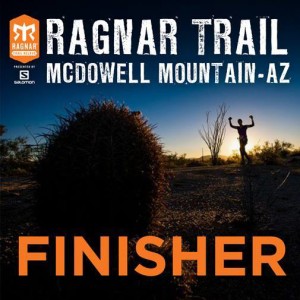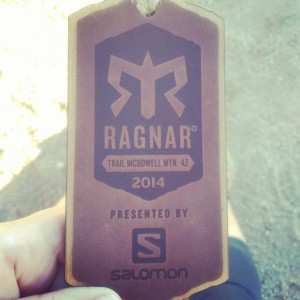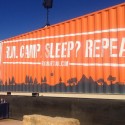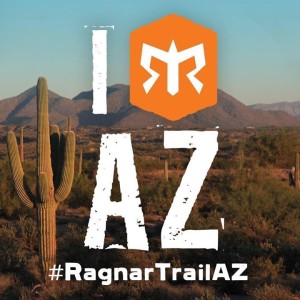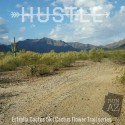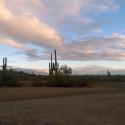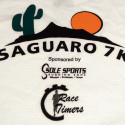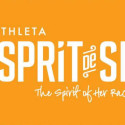So, I am a few months behind…. oh wait, what’s that? It’s been almost a YEAR? Boy do I suck!
Well anyway, I had an awesome experience running the Ragnar Trail Relay at McDowell Mountain last November! So much so that as SOON as we could register for 2015 I registered a team to do it again. And we run just about a month from now, so I guess I’d better get this review out there ASAP.
Here’s how I am going to break this down: I’ll start by giving you basic event info, tips for your team, the good and bad feedback for the event (most of it just suggestions for improvements because it was all pretty much awesome), and finally I’ll give you the play-by-play on how OUR race went.
Not interested in reading the whole shebang? Jump to what you want to read here:
- Race Breakdown
- Tips for Trail Ragnarians
- What to Pack
- Ragnar Trail Relay McDowell 2014 Race Feedback
- Our Race: The Agony of de Feet
THE RACE!
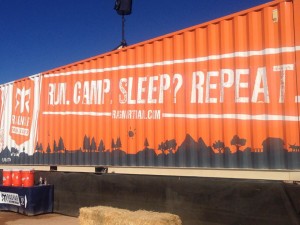
Let’s start by explaining exactly what a Ragnar Trail Relay is. It’s 8 friends camping out and taking turns running in the beautiful wilderness of whichever city/town/village the event is held in. Maybe you sleep, maybe you don’t!
The race consists of 8 adventurous runners, who each run three legs of the relay. Every runner runs the same three legs, just in a different, rotational order. There are three loops for the race:
- The Green: typically the shortest, and/or easiest of the loops
- The Yellow: typically a mid-distance loop with technical terrain (read steeper ascents, trickier and narrow trails, rocky terrain, etc…)
- The Red: a blend of technicality and distance, and typically the longest of the three loops
What time of day you run is dependent on when the runners before you finish. I built a chart based on our team’s start time and average pace to help us get a general idea of when each of us would be running, and it was pretty accurate and helpful for planning naps and meals around the run.
Here’s a graphic I, *ahem*, borrowed from Ragnar that sums up the running quite nicely, as well as a map of the loops:
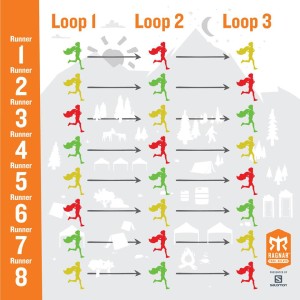
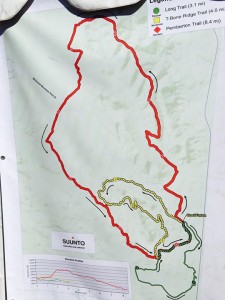
The race starts on Friday morning, with the start time assigned dependent on the average pace of your 8 runners. Faster teams start a bit later, and slower teams start earlier to ensure they finish before the race cutoff time on Saturday. All teams set up a campsite for the weekend, so if you can get some teammates to show up on Thursday night for setup, you’ll save yourself some time spent in the sun getting situated.
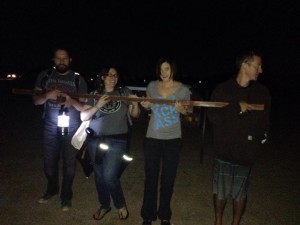
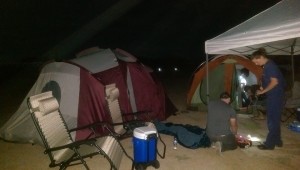
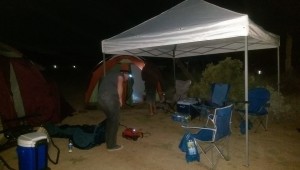
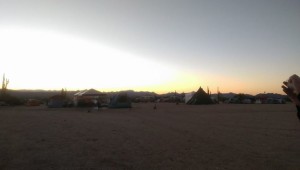
The Village provides entertainment, vendors, food & drink (some for purchase; some, like the spaghetti dinner, come with your registration), shopping and amenities such as massages. You can get some Ragnar gear, sample products by various vendors (and buy some, too), enjoy some s’mores at the bonfire, listen to some live entertainment, or just relax while you wait for your runners to come in.
Ragnar teams come up with clever names and costumes to differentiate themselves from the other teams, and as such there will be no lack of entertainment as you watch teams come to the transition tent. Last year there were 2-3 teams in kilts (the Kilty Pleasures), a team dressed up in giant Red Solo Cup costumes, teams in tutus, teams in colorful wigs, a team that ran in cutoff jean shorts (yikes!), and much, much more. It’s fun to dress in a theme, but don’t be intimidated and think you need to. We threw our team together so last minute last year that we just had a good time. There were no team shirts, logos, or other costume gear, just 8 friends having a good time. We have plans for our team this year though and I’m pretty psyched. Just don’t let the thought of not having a cohesive costuming strategy stress you out of dissuade you from participating.
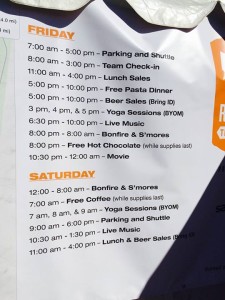 The transition tent in the village has three sections marked for the loops you will run. As your runner comes in, they give you the race bib belt, return their loop slap-bracelet, and you get a slap bracelet for your loop. Next to the tent are TVs which show when a runner is under a mile away from the transition area. Volunteers along the course look at race bibs and send the data back to update the chart. Since the TVs are only available at the transition tent, knowing approximately how long your runner should be out there is good not only for timing the next runner’s arrival at the tent, but also for alerting staff if they are gone longer than you anticipated in the event that they are injured, lost, etc…
The transition tent in the village has three sections marked for the loops you will run. As your runner comes in, they give you the race bib belt, return their loop slap-bracelet, and you get a slap bracelet for your loop. Next to the tent are TVs which show when a runner is under a mile away from the transition area. Volunteers along the course look at race bibs and send the data back to update the chart. Since the TVs are only available at the transition tent, knowing approximately how long your runner should be out there is good not only for timing the next runner’s arrival at the tent, but also for alerting staff if they are gone longer than you anticipated in the event that they are injured, lost, etc…
The transitions continue all through the day and night, with plenty of downtime at to rest, refuel, play Cards Against Humanity (or something else if you’re not into that sort of thing), catch up on your reading, etc… You can grab a massage, check out the vendors, chill by the bonfire, or just relax and wait until it’s your turn again.
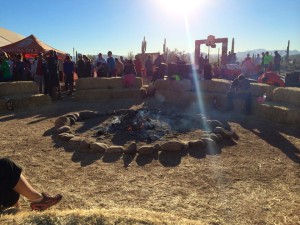
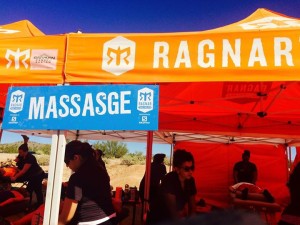
See how laid back it all is? Running shmunning. Let me tell you this: I am not a “runner” if the definition of a runner involves someone who runs regularly (at least every week, if not at least a few times a week). I barely run. I run when I know I have a race coming up, but you could never call what I do “training” because I don’t do enough of it. What I DO is RACE. I am not a fast racer, but I like running best when there is a medal waiting for me at the end. Doing a Ragnar Relay, whether on the trail (my favorite) or in a van on the road (also fun), with a bunch of your friends, is hands down the most fun kind of running there is, and as long as you’re generally physically fit (i.e. a doctor would not discourage you from running), you can run a Ragnar Relay.
Tips for Trail Relay Ragnarians (Especially McDowell Mountain)
- DO assemble a team of great people! Don’t have enough friends willing to camp and run with you? Throw up a smoke signal on the official race event page and open up your team as “looking for runners” on the my ragnar website (my.ragnarrelay.com). Or just do like we did and convince that neighbor of yours that you see out running all the time that they definitely want to join you for some running shenanigans that comes with a badass medal.
- DO train. Ok, so I didn’t train. A lot of us didn’t train. One 8-mile run the weekend before the race isn’t training. Even if you run often, if you don’t run mostly trails, I encourage you to get out there and train on trail terrain. Experience the rocks, the dirt, the hills and descents, to get mentally and physically ready. Even when you sort of know what is coming, it can be tough (if you ran this last year you know what I mean when I say the ascent on the yellow loop, and that last hill where all three trails met, was brutal). Not sure where to start? Ragnar provides two different training plans for beginner and intermediate runners.
- DO get some of your teammates out there on Thursday night, if you can. I’m sure each Ragnar is different, but for Arizona there is a small camping area next to Ragnar village, that’s not huge and can fill up pretty quickly. This camping area is ideal if you are an Ultra team (4 crazy people instead of 8 running the same distance), or if you expect to complete the race legs quickly (less walking for your runners). The village is also great if you want to be really close to the action. That being said, even the main camping area starts to fill in pretty fast come Friday morning, so if you want to stake out a spot that means easy access to the portable toilets, or less walking to the village, getting there early is your best bet.
- DO transition in teams of two. After running a hard loop, or a hot loop, or ANY loop, it’s nice to have a teammate waiting for you in the transition area with some cold water, and maybe even a snack to refuel. At night, when most of the camp is passed out, it’s even nicer not to walk back lonely in the dark where you can get a little lost among the tents. We tried to plan each transition in a “buddy” system where someone who doesn’t have to run for a bit accompanies the next runner down, and the returning runner back up to the camp. It’s not necessary, but it’s a nice touch. Plus having a teammate cheer you on as you cross is very motivating.
- DO have fun! I know some teams are very competitive, but don’t forget to have a good time too! Our team went into the relay knowing we just wanted to finish it and have a good time. Unless you’re up there with the top athletes and are legitimately trying to win, better to run your best, not stress, and enjoy the whole shebang.
- DO thank your volunteers and staff REGULARLY. These people, a great many of them friends and family to the other runners, are giving up their personal time to make sure we have what we need, keep us safe, and keep the event running smooth as butter. They’re standing in the hot sun, or staying awake in the wee hours of the night to keep the event safe and enjoyable for everyone. Let them know you appreciate them every chance you get!
What To Pack
Other than the official Trail Guide, the race-essentials that are required (i.e. headlamp, cups for hot and cold beverages, etc…) and the basics you wouldn’t dream of forgetting (deodorant, sleeping bags, pillows, tents), you’ll want to ensure you pack the following items for the best race experience. For the larger/campsite items, meet as a team ahead of time to determine who will supply what so you don’t end up with more than you need.
- A canopy to sit under. And some sides to hang off of it to block the sun as it moves throughout the day. The day gets warm FAST and your tent will quickly go from comfy sleep-space to full-on oven so you will want a sun-shaded oasis to retreat to.
- Food and LOTS of water (and coolers). Bring protein, carbs AND fat. Bring gallon jugs of water (or one of those big 5 gallon reusable containers) and refill your cup all day. You don’t want to get caught out on the course under-hydrated OR under-nourished. Trust me on this one.
- Ear plugs if you are a light sleeper. If you’re trying to nap during the day between race legs this is your best bet. The campsite quiets down quite a bit at night (at 2 in the morning I could almost hear a pin drop) but there’s still some ambient noise that would keep light sleepers awake.
- Three sets of head-to-toe clothes to run in – one for each leg. I recommend packing 2 gallon ziplock baggies to zip them up in once you change into your regular, relaxation clothes, to keep the tent from getting stinky.
- Trail Running Shoes. Trail running shoes provide some additional support and protection against the rocks, etc… you’ll be running over. They aren’t absolutely necessary, but I think you will prefer running in them. Be sure to break them in well in advance to avoid blisters.
- Clothes to relax in. You don’t want to sit your sweaty, stinky clothes after you run. Bring something comfy to lounge around in until it’s time to run again. For Arizona, I recommend packing shorts AND pants (for the chilly nights), and a light jacket. This also includes some comfy shoes – flip flops, non-running shoes, etc… whatever you will be comfortable in.
- Warm clothes and bed-things to sleep with. It’s the desert, so even though it was in the 90’s during the day, it was pretty chilly at night. In contrast, I don’t recommend over-dressing for your night run. I wore my badass Ragnar jacket because I was cold walking down to the transition area. And then I ran in it, and 5-10 minutes later I was soaked in sweat and couldn’t take it off because it was too cool outside and I would have made myself sick. Next time I will run in a thin, long-sleeved shirt instead. This advice may be most applicable to this specific race, and cooler climates might dictate warmer running attire. Just be sure you know what the weather is expected to be like and plan accordingly based on what you are comfortable running in for that weather.
- Baby wipes. You’re gonna feel hella gross after running. Baby wipes, or similar will make you feel a lot better. It’s not exactly a shower, but it’s better than nothing!
- Foam Roller & The Stick. DO NOT forget these essential tools! You will want to roll out after each run, even if you manage to get a massage at the massage tent. Lacrosse balls are great too. I promise your muscles will thank you.
- Entertainment. The race will have music in the village, a bonfire, and you’ll be hanging out with your friends; but there is still a generous amount of downtime in between legs. Consider bringing games that travel easy (Cards Against Humanity anyone?) to help pass the time, or a book to occupy your time in the event you find yourself the only one awake at camp, etc…
- Spare Batteries/Solar Power. Spare batteries for flashlights and headlamps are nice to have on hand if yours die. And if you’re running with your phone or an iPod for music, GPS, etc… you might need to re-charge throughout the race, so having solar power or a rechargeable power pack on hand will save the day!
- Camping Chairs. At least 6-7 among the group to ensure everyone has a comfy place to rest during downtime.
- A Folding Table. Creates a good place to set up food, drinks and gear that doesn’t involve ducking in and out of a tent repeatedly, and which wont interrupt anyone catching a cat-nap between legs
- Trash Bags (if you set up camp on Thursday night). Bring at least two – one for trash and one for recycle. You’ll get some on race day, but if you set up early you’ll want something sooner.
- Other essentials. What else could you need? Here is a quick rundown: tissues/TP, toothbrush & toothpaste, mints/gum, cash (for the food trucks), ID, hand santizer, prescription medications, pain reliever, Benadryl, anti-chafing gel, compression gear, etc…
Race Feedback for Ragnar
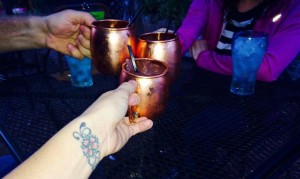
The night after the race, after a good amount of rest, our team and another team we’re friends with got together for dinner to celebrate, and came up with the following observations for things that were great, and things that could be improved upon at the next event. Here’s hoping some of this feedback is helpful and we see some improvements for this year’s race.
Race/Event Specific
- The virtual captain’s meeting that took place before last year’s race was scheduled in the wrong time zone, and many of the captains I know missed it. Remember that Arizona is on Pacific Time this time of year.
- While there are LOTS of great guides out there on many blogs (and I’ll be including one here myself) it would be nice to see an essential packing list in the Trail Guide as a reminder to Ragnarians on what they’ll want to bring along! (for example, extra batteries for headlamps, a flashlight, etc…)
- The safety video was funny! Do you know what that means? It means runners who were more likely to pay attention. Good job, Ragnar! One quick thought though: add some commentary about participant etiquette (leave space between your campsite and others for safely walking through at night, throw your trash and recycling in the appropriate containers, etc…
- The trails were well-marked. Whenever a poor or confusing trail marking was brought to staff attention, it was corrected/improved before our next runner of that trail went out.
- The Yellow loop was TOUGH STUFF. Even though the distance isn’t much compared to the Red loop, it would be nice to have a tent with a volunteer or two out on that loop with some water and medical attention for those who might need it.
- The transition tent TVs didn’t offer much in the way of shade, and we had hotter than usual weather (and that’s always a gamble in Arizona). It would be great if a TV with the incoming runner information could be made available in the bigger mess-hall area which offered MUCH shade.
- Most of these races are probably far enough off the beaten path that this wouldn’t make much sense, but for McDowell it would be nice if there was an app that teams could download where they could sign up to be alerted or otherwise see the same info available on the transition TVs to know when their runners are coming in. It would cut back on crowding at transition for sure.
- And speaking of tech, since there is a hashtag for the race in general, it would be nice to see a hashtag just for alerting the race organizers of medical issues, etc…, or even a feature built into an app that would allow for it.
- Don’t skimp on the fanfare for the teams who end later in the Saturday. Some teams crossed the finish line with hardly any fanfare (ours included, and we were not last). The photographer for the group photos and the announcer didn’t even notice we had finished. I watched a number of other teams run in for the group finish and was disappointed when our team did not get the same attention/cheering/etc… It’s a great accomplishment by itself, but cheering people on is invaluable after that much running, and especially for these teams that end later.
- The shirts didn’t fit well. There was NO stretch at all in the material, and the women’s shirts didn’t fit our arms without going larger than normal. I was just thankful I was able to swap mine a size up with another runner (because there weren’t enough extra to swap it with the shirt staff) even if it is still a little tight in the arms.
- The volunteers were awesome! Upbeat, friendly, helpful… A volunteer shirt doesn’t even seem like enough. It would be kind of neat if the captain could buy a “volunteer gift” that gives the volunteers some cash to spend in the gear store as a thank-you from the team, especially if you “buy” a volunteer (since you wouldn’t know who they are to be able to personally thank them).
The Village
- The band needs some shade – it was uncharacteristically warm during last year’s relay and while we appreciated the live music, we felt bad that they had to perform in the hot, direct sunlight. I was getting a little overheated just sitting there listening to them for the short time I did.
- Move the village portable toilets (or add some) closer to the transition tent for runners waiting to transition. The lines could get long at the village toilets and the distance between the toilets and the transition area left some runners coming in from their run waiting for their team mates.
- Bonfire = AWESOME. Bonfire right next to transition area = NOT SO AWESOME. The location of the bonfire resulted in a lot of smoke in the eyes and smoke inhalation. The wind can’t be controlled, but moving the bonfire a bit further back from the transition area would definitely help.
- The Trail Guide emphasized bringing your own reusable cups in an effort to be environmentally friendly, and then there were all kinds of places handing out cups. I would MUCH rather see reusable cups being sold for those who forgot them. I would also encourage some additional water stations for filling up cups/bottles/hydration packs.
- The massages were awesome, they were very high quality! Staggering times would have been helpful so that runners later in the day could take advantage, but overall massaging sweaty people without complaint got many thumbs up!
Main Camping Area
- The camping area was easy to access, parking was good, and the fees to camp the night before were entirely reasonable. It might help to have camping spaces marked out, or volunteers on hand to assist teams in making sure they take up only the allotted space.
- More portable toilets are needed – there was only one “bank” of portable toilets at the event, and while there were probably about 60 of them, toward the end of Friday night they were getting pretty stinky and low on resources, with half a day of running left yet.
- Speaking of portable toilets, the area for the restrooms should be clearly marked off so that the path to reach them does not get blocked by campers, and so campers don’t need to relocate their tents after setting up (which can take some time!). Early on Friday several camps were set up at the far end of the toilet setup, and people had to cross through their campsites to get to the path (and the campers weren’t too pleased). Later in the day we noticed volunteers had these campers relocate their campsites to open the area up.
- Even with the trash and recycling bags, trash was still an issue. The signs indicating which dumpsters were for trash vs. recycle fell down almost immediately because they were put up with duct tape (which melted in the sun) rather than strung up with rope. Also, with teams coming up on Thursday night, it would be nice if up to a certain time in the evening teams could go collect their trash and recycle bags early. We did bring our own in just case, but it would be nice.
- Changing in a tent is kind of tough. It would be cool to see some stalls set up specifically for changing so that runners can stand up and change someplace clean.
Food
- The pasta dinner is a nice touch and much appreciated, but well all agreed it was kind of bland and completely lacking in protein. Throw a few meatballs in there (for those who want them) and we’ll be set!
- Speaking of the dinner, the line was lengthy – consider forming two lines to get runners through a bit quicker.
- Speaking of food, there weren’t many options with the food trucks during the day, and the lines could get kind of long. Arizona has TONS of food truck businesses – I’d love to see a few more represented to add some variety and cut down on lines.
- Consider local brewers as sponsors! Sierra Nevada is the official beer sponsor, but Arizona has NUMEROUS local breweries (San Tan and 4 Peaks to name two of the larger brewers). It would be nice to see beer for sale that puts money back into our local economy, if possible.
Vendors & Shopping
- There was a great selection of vendors (NUUN, Goal Zero, Salomon and many others)!
- The gear store had lots of stuff to wear, but a place to buy some small supplies, such as sunscreen, body wipes, earplugs, bandaids, sunglasses, hair tires, chapstick, ice packs (for cooling off), and hand warmers would be AWESOME for the teams that simply forgot to pack something essential, or underpacked/ran out. Additionally, having some hydration packs/reusable running water bottles and some of those cooling towels (it is Arizona heat after all) would be SWELL.
- Bring back trail relay apparel! I LOVE the motto “8 Friends, 3 Trails, 1 Billion Stars, Unforgettable Stories” and the cute logo that goes with it, but there was not a SINGLE shirt or otherwise with this imprint last year. Even after the race, and even after providing the feedback that the online apparel store was only offering regular relay apparel, a year later I still have not seen a single shirt with that logo (I check back often), and it bums me out, man.
If you’re with Ragnar, and you read our feedback above, THANK YOU! We so appreciate everything you do to put on this massive event all over the country, in THIRTEEN different cities, every year. You’ve given us a most awesome race that we can’t stop bragging about. There is always room for improvement, and we hope that some of the feedback we’ve assembled is valuable and considered thoughtfully. Cheers!
Our Race Experience: Agony of De Feet
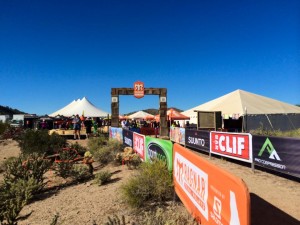
Ragnar Trail Relay at McDowell Mountain is held just outside Fountain Hills, AZ and ended up being a bit closer to civilization than we had expected it to be (and probably closer than many of the other trail relays likely are). We had cell phone service pretty much the entire time, making it easy to share our photos throughout the event, post our race trackers, and tweet the #RagnarTrailAZ hashtag. If anything the GPS on the phones (at least mine) cut out a few times, so a Garmin-style device is probably still a better bet if you like to track that sort of thing. We brought solar chargers as well as rechargeable battery packs which I was thankful for.
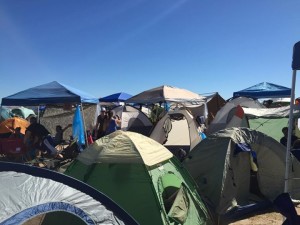 A few people from our team decided to go up to the race site the night before to establish our camp space for the weekend, and it worked out perfectly. Hardly anyone came up the night before with the exception of the Ultra teams near the Village, so we were able to score an awesome spot right near some bushes that put a little bit of space between us and the other teams.
A few people from our team decided to go up to the race site the night before to establish our camp space for the weekend, and it worked out perfectly. Hardly anyone came up the night before with the exception of the Ultra teams near the Village, so we were able to score an awesome spot right near some bushes that put a little bit of space between us and the other teams.
By around 8am the next morning the campsites were already filling in and by mid-day you had to carve paths between camps to get to your spot. We made finding ours easy by hanging some battery-powered Christmas lights from our canopy – well worth it to find your way back to camp after running a middle-of-the-night leg.
The day was HOT, so having some sides hung off our canopy to block out the sun made the breeze that was passing through a lot cooler than it normally would have been, and I was even able to catch a cat-nap in a camping chair with a foot rest.
We carefully planned out approximately when each runner would start each leg based on our team start time and each racer’s approximate pace time. It ended up being pretty accurate! We also came up with a system of always checking in with the running two legs beyond our own before we headed down to the transition tent so that each runner had plenty of time to fuel up, get hydrated, change and be ready to run. This was especially helpful during the evening runs, and allowed the night runners the ability to catch a few ZZZs.
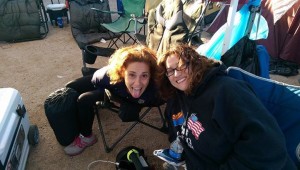
My own race legs went from the Green Loop as the sun was setting, the Red Loop at about 2am and the Yellow loop around noon on Saturday. I felt good on the Green loop but my pace really was quite a bit slower than my road pace. Both 5ks I ran prior to McDowell had paces around 11:30mm but my pace for the 3mi Green loop was 13:27mm. Each loop after that slowed down even more, with my red loop at 15:21mm. That one was tough to maintain a good pace on due to the long hill climb at about mile 2 and the run through a sandy wash that felt like it was taking forever. When I came back from that loop, the whole camp was asleep, or running, so I quickly changed and hopped into my sleeping bag to get some sleep. Unfortunately, not eating and drinking enough after such a long run, coupled with the fact that I had been sweating through my jacket that I should not have run in for 8.4 miles, made me a bit ill. I had the chills and was sweating for about an hour in my sleeping bag before I FINALLY fell asleep. I did wake up with some awesome bed head though.
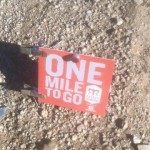
My last loop, the yellow, I could barely pick my legs up (this is why I strongly recommend rolling out, which I DID NOT do, depsite having packed my foam roller). I walked the entire 4 mile loop, and it took a LONG time. To give you some perspective, I walked the 4 miles in an hour and 18 minutes, approximately the same time it took Christine, pictured in our awesome bed-head photo above, to run the entire 8.4 Red loop at 2pm in the hot sun. And I’ll tell you, that One Mile To Go marker felt like the biggest tease, especially after the trail started to curve toward the finish line (YAY!) and then broke away from it on me! Honestly, there was nothing more beautiful than that finish line at the end of my last leg.
Overall, the race was a great experience, and one that not only WOULD I do again, but one which I AM doing again in FIVE WEEKS! I’m hoping to improve my times this year, but not holding my breath. For me, this race is an experience. I know we will not be first, and will likely not be last, and I’ve got TWO medals coming to me for completing it. Let’s be real, I am in it for the bling.
